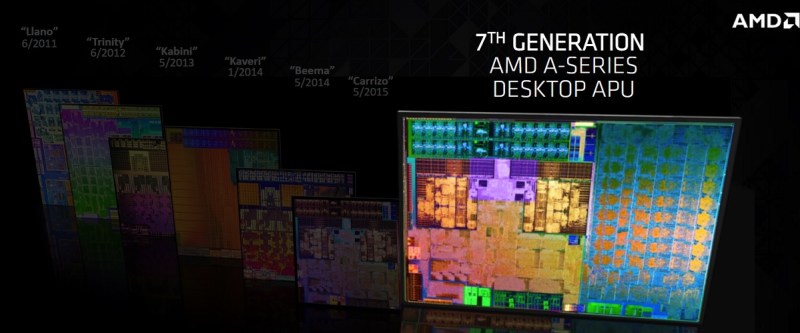Advanced Micro Devices is announcing that desktop systems with its 7th-generation AMD A-Series processors are shipping today.
The new systems are based on AMD’s code-named Bristol Ridge accelerated processing units (APUs), which use AM4 sockets and are aimed at offering performance, streaming, graphics, and power efficiency. These processors compete with Intel’s latest code-named Kaby Lake processors, known formally as 7th Generation Core processors.
Sunnyvale, Calif.-based AMD estimates that over 10 trillion seconds are spent with PCs every day. I haven’t fact-checked that number, but it sounds about right to me.
“The important thing as innovators of technology is to drive to make sure that those 10 trillion seconds are more productive, more immersive, and more energy efficient,” said Peter Amos, a spokesman for AMD, in a press briefing. “That’s the driving force behind our product development.”
AI Weekly
The must-read newsletter for AI and Big Data industry written by Khari Johnson, Kyle Wiggers, and Seth Colaner.
Included with VentureBeat Insider and VentureBeat VIP memberships.

Above: AMD A-Series is the 7th generation of APUs.
The new processors are APUs, or those that combine a microprocessor and graphics functions on the same chip. They will ship later this year in Hewlett-Packard and Lenovo devices. Equipped with DDR4 memory, these devices will deliver excellent energy efficiency and broad bandwidth, enabling high-speed processing and smooth esports gaming, with enhanced HD streaming capabilities, AMD said.
“We are excited for the first consumer release of the AMD AM4 socket and the first integration of our 7th Generation AMD A-Series processors into desktop devices,” said Kevin Lensing, corporate vice president and general manager of Computing and Graphics at AMD. “At AMD, we are continually working to drive innovation that our customers want, including superior energy efficiency and the best streaming and graphics capabilities available.”
The systems will have chips that have up to four Excavator central processing unit (CPU) cores each. AMD recently announced its Zen cores, which have 40 percent more performance per clock than the Excavator cores. But systems with those cores won’t ship until late this year or early next year. The Excavator CPU has 17 percent higher single-threaded performance than the previous generation.
The CPUs are paired with AMD Radeon GCN 3.0 cores that run at 1.1 gigahertz. These graphics cores have support for VP9 and HEVC video streaming standards. The performance is 27 percent better on graphics than on the previous generation.
The 7th Generation AMD A-Series desktop processors consist of 65-watt and 35-watt versions, making it so they can fit in a variety of form factors. The previous generation consumed 95 watts. The processors have video playback features supporting up to 4K Ultra HD in both the popular H.264 and new-and-improved H.265 formats.
The 35-watt AMD A12-9800 chip at 65 watts has equal performance to the Intel i5-6600K at 91 watts, AMD said. AMD also has 99 percent higher graphics performance than the Intel chip. On energy efficiency, AMD said its chip is 32 percent better in system efficiency. AMD’s 35-watt chip can also outdo the Intel i5-6500 65-watt chip, AMD said.
“The 7th generation parts deliver on performance, and they also deliver on efficiency,” said Amos. “We’re equipped to handle what is needed today and tomorrow.”
The AMD chips will use the AM4 platform, which is designed to last multiple generations, said Don Woligroski, global marketing manager for Desktop Processors at AMD. AMD has a number of chip sets that will support the AM4 platform.
VentureBeat's mission is to be a digital town square for technical decision-makers to gain knowledge about transformative enterprise technology and transact. Learn More
